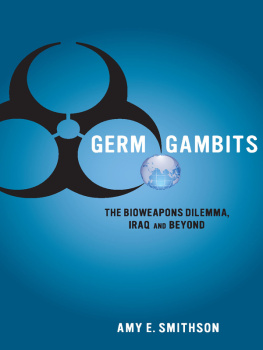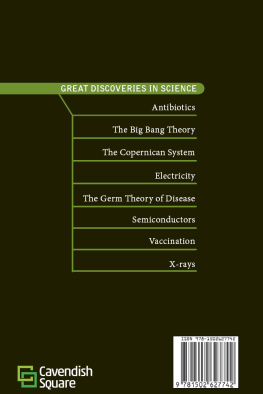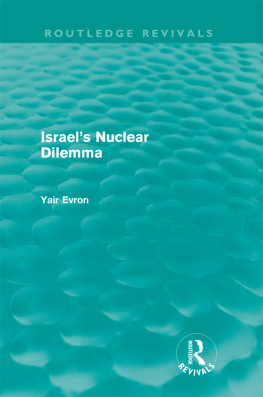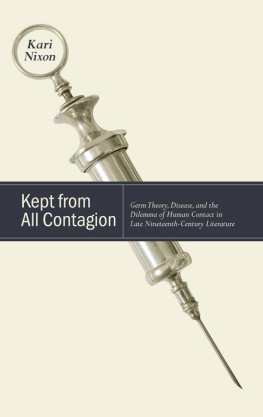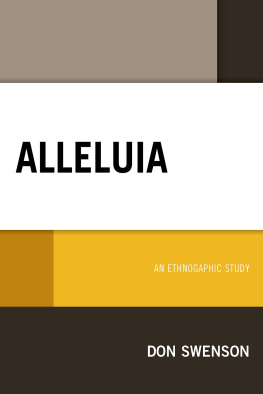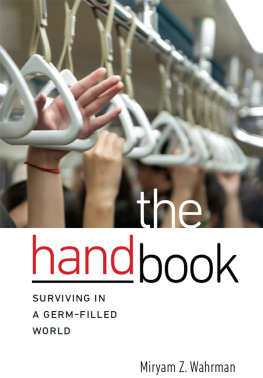Stanford University Press
Stanford, California
2011 by the Board of Trustees of the Leland Stanford Junior University.
All rights reserved.
No part of this book may be reproduced or transmitted in any form or by any means, electronic or mechanical, including photocopying and recording, or in any information storage or retrieval system without the prior written permission of Stanford University Press.
Special discounts for bulk quantities of Stanford Security Studies are available to corporations, professional associations, and other organizations. For details and discount information, contact the special sales department of Stanford University Press.
Tel: (650) 736-1782, Fax: (650) 736-1784
Printed in the United States of America on acid-free, archival-quality paper
Library of Congress Cataloging-in-Publication Data
Smithson, Amy E., author.
Germ gambits : the bioweapons dilemma : Iraq and beyond / Amy E. Smithson.
pages cm
Includes bibliographical references and index.
ISBN 978-0-8047-7552-6 (cloth : alk. paper)ISBN 978-0-8047-7553-3 (alk. paper)
1. United Nations. Special Commission on IraqHistory. 2. Biological arms controlVerificationIraqHistory. I. Title.
UG447.8.S585 2011
327.174509567dc22
2011015778
Typeset by Classic Typography in 10/14 Minion
E-book ISBN: 978-0-8047-8071-1
FOREWORD
Rolf Ekeus
THE DECISION IN April 1991 by the United Nations (UN) Security Council that Iraqs weapons of mass destruction should be eliminated is an event in history with only one precedent, the decision under the Treaty of Versailles in 1919 that Germany, defeated in the First World War, should be fully disarmed. In the end the mission to disarm Germany failed, due to Germanys systematic obstruction of the efforts by the Allied Control Commission, responsible for implementing the provisions of the Treaty.
The disarmament of Iraq was the major component of Security Council Resolution 687(1991), constituting the ceasefire in the 1991 war between Iraq and a coalition led by the United States in support of the liberation of Kuwait.
The Special Commission, UNSCOM, set up by the Security Council to oversee the disarmament of Iraq was, like the Control Commission, faced with systematic obstructions. However, as we now have learned, UNSCOM overcame a multitude of challenges. When it effectively ended its operations in Iraq in late 1998, UNSCOM had thoroughly cleansed Iraq of its prohibited biological and chemical weapons, equipment, and installations, as well as its means of delivery, including relevant missiles. Also, nuclear weapons capabilities had been eliminated in cooperation between UNSCOM and the International Atomic Energy Agencys Action Team, specially created for the purpose of taking care of Iraqs nuclear capability.
The by far most difficult task for UNSCOM, embodied in its mission, was to identify and eliminate Iraqs clandestine biological weapons (BW) program.
This is the story of how this was done. Amy Smithson has approached her task of telling that story in a way that penetrates the complexities; clarifies the many obscure points; describes the operations; and provides understanding of the science of biological weapons research, development, and production. In addition, she demonstrates an understanding of the formidable political, organizational, and methodological difficulties facing UNSCOM, its leadership, and its inspectors, something which only a few commentators and observers have been able to do.
Iraqs biological weapons program constituted the most secret elements of Iraqs total destructive capabilities. The existence of BW in Iraq was denied from the beginning of UNSCOMs operations. That explains why it took UNSCOM four years of intensive work until the inspections yielded results. Not until spring 1995 could the Special Commission make the first disclosures to the UN Security Council about the existence in Iraq of the top-secret BW program, although Iraq did not admit this until July 1995, when officials acknowledged an offensive biological weapons program. In early August they also recognized that Iraq in late 1990 had weaponized its warfare agents by filling them in bombs and in a number (twenty-five) of missiles. The political impact in Iraq of these disclosures rocked the stability of the regime, with the lasting effect of undermining the power structures around Saddam Hussein, the president of the country. Thus Saddams son-in-law Hussein Kamal, who had been put in charge of all activities relevant to Iraqs weapons of mass destruction, in August 1995 defected to Jordan, though he later returned to Iraq and was killed by the regime.
It must be stated that one non-technical reason for UNSCOMs progress and final success in eliminating the prohibited items in the face of Iraqs obstructive policy was that, as a subsidiary organ of the Security Council, it normally could enjoy the support of a united Council in pressing Iraq to accommodate the inspectors in matters of access to facilities, aerial surveillance, and so on. It fell upon UNSCOMs leadership to cultivate Security Council unity in support and understanding of the Special Commissions operations. In 1998 the unity in support for UNSCOM fell apart. Even if UNSCOM as an institution finally broke, it must firmly be stated that its mission before that had succeeded.
It is generally recognized that verification and monitoring of the implementation of the prohibitions of the 1972 Biological and Toxin Weapons Convention is a challenging task. Some governments even maintain that a verification protocol to the BWC would not be workable. UNSCOM, admittedly armed with far-reaching rights and strong technical and political backup, could prove the opposite, namely that a verification and monitoring system could work even under the most difficult and challenging conditions. Thus the team of inspectors who succeeded in identifying and eliminating Iraqs secret BW program did what many thought would be impossible, namely to disclose a highly clandestine BW program. The work took its time. It was not until mid-1996 when the sprawling Al Hakam biological warfare agent production facility could be finally destroyed.
In this book Amy Smithson tells the fascinating story of how the BW inspectors, through brilliant individual and collective work, succeeded in breaking the Iraqi resistance. She describes in detail how UNSCOMs methodological approaches, based upon material balance analysis, fast laboratory analysis, and aerial surveillance from high and low altitude, backed up by photo analysis and systematic site inspections, including no-notice inspections and refined interviewing techniques, against all odds led to detection, disclosures, and, ultimately, success.
With a great sense of humor and in almost literary terms she describes the individual inspectors, their personality profiles, and their very different temperaments and intellectual approaches, all based on repeated interviews. She gives each one of them their due, such as the heroic, and ultimately tragic, personality of David Kelly.
Iraqs denials and falsified declarations, the intimidating attitude of the Iraqi counterparts, physical obstructions of the inspectors, and the political games played by the government constituted tremendous obstacles for the inspection regime. In this book Amy Smithson gives us a narrative on how UNSCOM succeeded in overcoming these obstacles. To quantify the extent of progress made by the BW inspection team, one should note that Iraqs original declaration in 1992 on its holdings of declarable material amounted to 17 pages and in 1997 to 639 pages.

